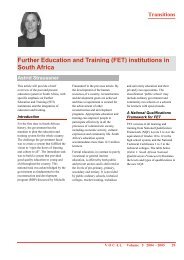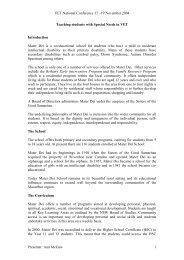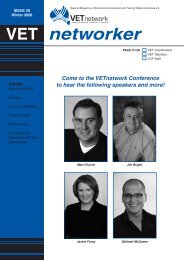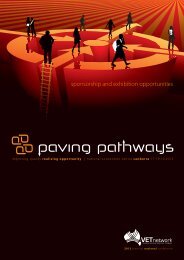QSA Self-Assessment Tool for TAA40104 Certificate IV in Training ...
QSA Self-Assessment Tool for TAA40104 Certificate IV in Training ...
QSA Self-Assessment Tool for TAA40104 Certificate IV in Training ...
- No tags were found...
You also want an ePaper? Increase the reach of your titles
YUMPU automatically turns print PDFs into web optimized ePapers that Google loves.
the process.Part B – Structure of <strong>TAA40104</strong> <strong>Certificate</strong> <strong>IV</strong> <strong>in</strong> Tra<strong>in</strong><strong>in</strong>g and<strong>Assessment</strong> recommended by Queensland Studies Authority•nits of competency lement of competencyAAENV401A Work effectively <strong>in</strong>vocational education andtra<strong>in</strong><strong>in</strong>gAAENV402A Foster and promotean <strong>in</strong>clusive learn<strong>in</strong>g cultureAAENV403A Ensure a healthyand safe learn<strong>in</strong>g environmentAADES401A Use Tra<strong>in</strong><strong>in</strong>gPackages to meet client needsAADES402A Design and developlearn<strong>in</strong>g programsAADEL401A Plan and organisegroup-based deliveryAADEL403A Facilitate <strong>in</strong>dividuallearn<strong>in</strong>gAADEL404A Facilitate workbasedlearn<strong>in</strong>gAAASS401A Plan and organiseassessmentAAASS402A Assess competenceAAASS403A Develop assessmenttoolsAAASS404A Participate <strong>in</strong>assessment validationAADEL402A Facilitate groupbasedlearn<strong>in</strong>g1. Work with<strong>in</strong> the vocational education and tra<strong>in</strong><strong>in</strong>g policy framework2. Work with<strong>in</strong> the tra<strong>in</strong><strong>in</strong>g and/or assessment organisation’s quality framework3. Manage work and work relationships4. Demonstrate a client-focused approach to work1. Practise <strong>in</strong>clusivity2. Promote and respond to diversity3. Develop and implement work strategies to support <strong>in</strong>clusivity4. Promote a culture of learn<strong>in</strong>g5. Monitor and improve work practice1. Identify OHS responsibilities2. Identify hazards <strong>in</strong> the learn<strong>in</strong>g environment3. Assess risk <strong>in</strong> the learn<strong>in</strong>g environment4. Develop and implement actions to ensure the health safety and welfare of learnersand/or candidates5. Provide appropriate OHS requirements to learners and/or candidates6. Monitor OHS arrangements <strong>in</strong> the learn<strong>in</strong>g environment1. Def<strong>in</strong>e the basis <strong>for</strong> us<strong>in</strong>g Tra<strong>in</strong><strong>in</strong>g Package/s and accredited courses2. Analyse and <strong>in</strong>terpret the qualifications framework3. Analyse and <strong>in</strong>terpret competency standards and accredited modules <strong>for</strong> clientapplication/s4. Contextualise competency standards and accredited courses <strong>for</strong> clientapplication/s5. Analyse and <strong>in</strong>terpret assessment guidance <strong>for</strong> client application6. Use Tra<strong>in</strong><strong>in</strong>g Package/s and accredited course as an <strong>in</strong>tegrated tool <strong>for</strong> clientapplication1. Def<strong>in</strong>e the parameters of the learn<strong>in</strong>g program <strong>in</strong> consultation with the client/s2. Generate options <strong>for</strong> design<strong>in</strong>g the learn<strong>in</strong>g program3. Develop the learn<strong>in</strong>g program content4. Design the structure of the learn<strong>in</strong>g program5. Review the learn<strong>in</strong>g program1. Interpret the learn<strong>in</strong>g environment and delivery requirements2. Prepare session plans3. Prepare resources needed <strong>for</strong> delivery1. Identify <strong>in</strong>dividual learn<strong>in</strong>g facilitation requirements2. Establish the learn<strong>in</strong>g/facilitation relationship3. Ma<strong>in</strong>ta<strong>in</strong> and develop the learn<strong>in</strong>g/facilitation relationship4. Close and evaluate the learn<strong>in</strong>g/facilitation relationship1. Establish an effective work environment <strong>for</strong> learn<strong>in</strong>g2. Develop a work-based learn<strong>in</strong>g pathway3. Implement the work-based learn<strong>in</strong>g pathway4. Monitor learn<strong>in</strong>g and address barriers to effective participation5. Review the effectiveness of the work-based learn<strong>in</strong>g pathway1. Determ<strong>in</strong>e focus of assessment2. Prepare the assessment plan3. Contextualise and review assessment plan4. Organise assessment arrangements1. Establish and ma<strong>in</strong>ta<strong>in</strong> the assessment environment2. Gather quality evidence3. Support the candidate4. Make the assessment decision5. Record and report the assessment decision6. Review the assessment process1. Determ<strong>in</strong>e the focus of the assessment tool2. Determ<strong>in</strong>e assessment tool needs3. Design and develop assessment tools4. Review and trial assessment tools1. Prepare <strong>for</strong> validation2. Contribute to validation process3. Contribute to validation outcomes1. Establish an environment conducive to group learn<strong>in</strong>g2. Deliver and facilitate tra<strong>in</strong><strong>in</strong>g sessions3. Demonstrate effective facilitation skills4. Support and monitor learn<strong>in</strong>g














